Imagine you’re playing pickleball, and you’re in the perfect position to smash a volley right over the net—but wait! You stepped into the kitchen, and that means you just lost the point. If you’ve ever been confused about this mysterious part of the court, you’re not alone.
The kitchen in pickleball, officially known as the non-volley zone (NVZ), is one of the most unique and misunderstood aspects of the game. It plays a crucial role in preventing players from dominating the net and encourages strategic play.
We’ll break down exactly what the kitchen is, why it exists, and how to follow its kitchen rules correctly. Whether you’re a beginner trying to understand when you can step into the kitchen or an advanced player refining your net game, this guide will ensure you never lose a point due to a kitchen violation again.
What is the Kitchen in Pickleball?
The kitchen in Pickleball is a 7-foot area on both sides of the net, extending across the entire width of the court. It is officially called the non-volley zone (NVZ) because it is the only part of the court where players are not allowed to hit a volley (a shot hit before the ball bounces).
The primary purpose of the kitchen is to prevent players from standing too close to the net and smashing volleys repeatedly. Without this rule, the game would be dominated by net play, making rallies shorter and less strategic.
Why is it Called the Kitchen in Pickleball?
The term “kitchen” does not appear in the official rulebook, yet it has become widely used by players. There are a few theories about where the name originated:
- Borrowed from Shuffleboard: Many believe the term comes from shuffleboard, where the “kitchen” refers to a penalty area. In shuffleboard, landing in the kitchen results in negative points, similar to how stepping into the pickleball kitchen at the wrong time leads to a fault.
- Just a Fun, Random Name: Some players suggest that early pickleball players simply coined the term as a joke, and it stuck. It adds a fun, lighthearted feel to the game, which aligns with pickleball’s reputation as a social, easy-to-learn sport.
Regardless of its origin, the kitchen is a critical part of the game, and understanding its rules can help you avoid unnecessary faults and gain an edge over your opponents
How Big is the Kitchen in Pickleball?
The kitchen, also known as the non-volley zone, is a 7-foot deep area on both sides of the net, extending across the entire width of the court, which measures 20 feet wide. This zone plays a crucial role in preventing players from executing smashes or volleys too close to the net, maintaining fairness and strategic play.

The kitchen boundary lines are considered part of the non-volley zone, meaning that if a player steps on the line while volleying, it results in a fault. The 7-foot measurement is taken from the net towards the baseline on each side, effectively restricting aggressive net play.
Given that the total length of a pickleball court is 44 feet, the kitchen collectively occupies 14 feet of the playing area—7 feet on each side of the net—significantly influencing the game’s dynamics by requiring players to carefully control their foot positioning and shot selection.
| Kitchen Measurement | Size |
|---|---|
| Depth from the net | 7 feet |
| Width (same as court width) | 20 feet |
| Total area covered | 140 square feet |
Kitchen Rules in Pickleball
The kitchen rules are one of the most important aspects of pickleball. Violating them results in a fault, which can cost you a point or the serve. Below are the most important rules that every player must follow.
The No-Volley Rule
However, you cannot volley the ball while standing in the kitchen or touching the kitchen line. A volley means hitting the ball before it bounces. Even if a single toe is touching the kitchen when you make contact with the ball in the air, it is a fault.
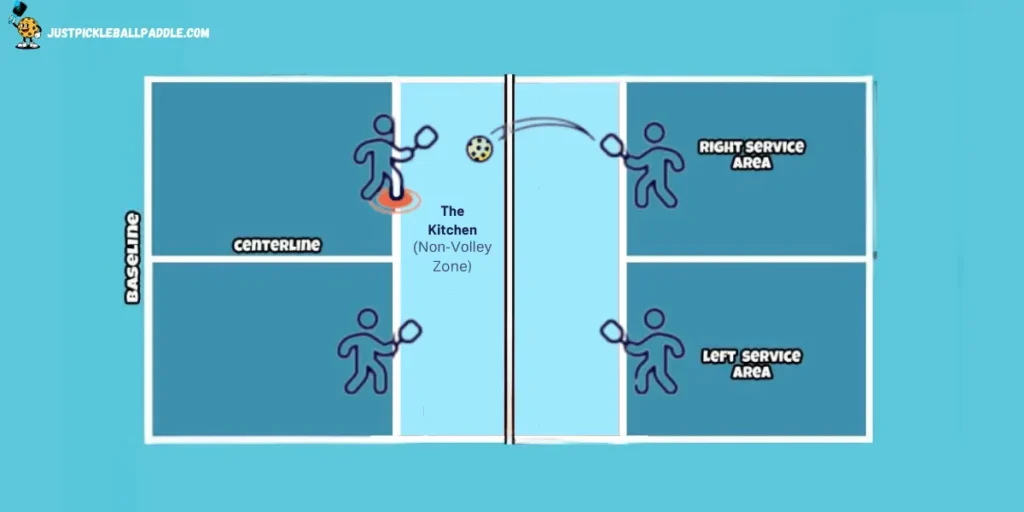
The rule also extends to momentum. If you legally volley the ball while standing outside the kitchen, but your movement carries you into the kitchen immediately after, it is still a fault—even if the ball is already out of play. The restriction applies to the entire action of hitting the volley, including your swing, follow-through, and momentum.
Because of this strict rule, some advanced players use a move called the Erne shot to get around the kitchen restriction.
An Erne is when a player steps outside the sideline and repositions themselves near the net, allowing them to volley a shot without stepping into the kitchen. Since they are positioned legally outside the non-volley zone, they can execute a volley at the net without committing a fault.
When Can You Step in the Kitchen in Pickleball?
Many players mistakenly believe they can never step inside the kitchen. However, you are allowed to step into the kitchen as long as you are not volleying. If the ball has already bounced, you can legally enter the kitchen to hit your shot.
This commonly happens during dinking battles, where players exchange soft shots close to the net. However, staying in the kitchen for too long can put you at a disadvantage, as it limits your ability to volley.
Skilled players step in, hit their shot, and then quickly reposition behind the kitchen line to avoid faults on the next volley.
Can You Jump into the Kitchen in Pickleball?
Jumping forward into the kitchen after hitting a volley is also illegal. Even if you are airborne when making contact with the ball, if you land inside the kitchen after the volley, it’s a fault. Some players attempt to volley while staying in the air, but this is a high-risk maneuver that can easily result in a mistake.
Can You Hit the Ball While in the Kitchen?
Yes, you can hit the ball while inside the kitchen, but only if the ball has bounced first. If a shot lands in the kitchen, you are free to step in and return it. However, remaining inside the kitchen for too long can be dangerous, as you won’t be able to volley without stepping out first
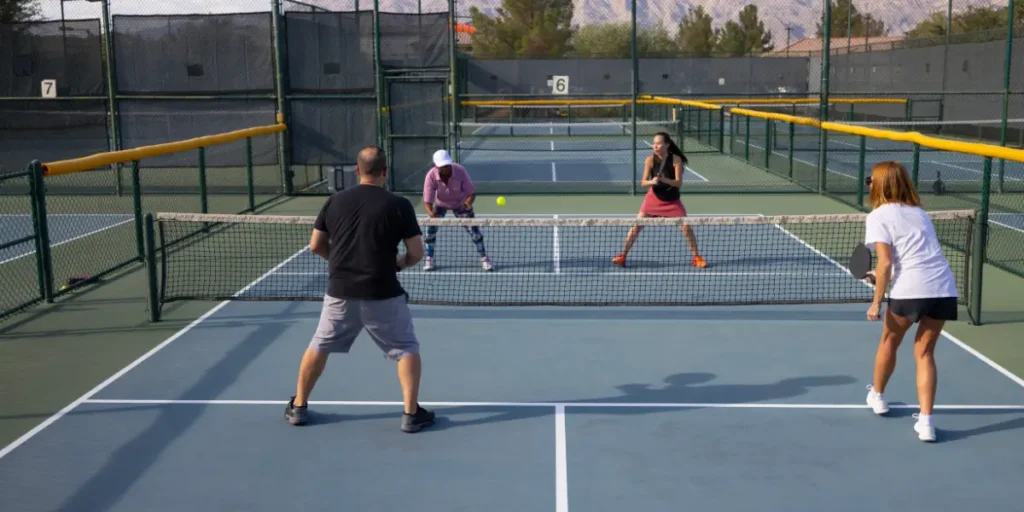
Can You Serve into the Kitchen in Pickleball?
No, a serve cannot land in the kitchen or touch the kitchen line. If it does, it’s an automatic fault, and your opponent wins the point. This rule ensures that serves are deep enough to promote longer rallies instead of short, unreturnable shots.
Additionally, a well-placed deep serve forces your opponent to stay at the baseline, preventing them from gaining an early advantage at the net.
Can You Spike in the Kitchen in Pickleball?
Spiking from inside the kitchen is only legal if the ball has bounced first. If the ball is still in the air and you attempt to smash it while standing in the kitchen or touching the kitchen line, it results in a fault.
This rule exists to prevent players from camping at the net and aggressively smashing volleys, which would make the game one-dimensional and remove the need for strategy.
Instead, spiking is typically performed from just outside the kitchen line, where players can execute a legal volley without stepping into the non-volley zone. Skilled players use this positioning to create powerful overhead smashes while still following the rules.
So you want to play spike in pickleball must follow the rules.
How Does the Kitchen Work in Pickleball?
The kitchen, or non-volley zone, is designed to prevent players from dominating the game with aggressive net play. Unlike other racket sports where players can stand at the net and smash volleys, pickleball enforces a no-volley zone to keep rallies balanced and skill-based.
By limiting volleys near the net, the kitchen encourages players to use soft, controlled shots instead of power smashes. This leads to a playing style called dinking, where opponents carefully hit slow shots into the kitchen, forcing each other into a battle of patience and precision.
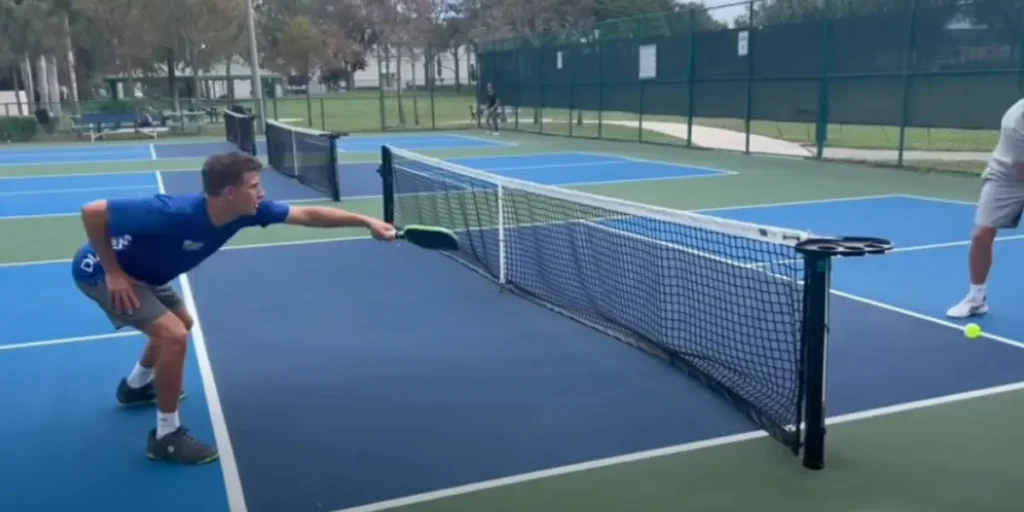
Strategically, smart players hover just outside the kitchen line, allowing them to volley shots when needed but also step in quickly when the ball bounces. Good footwork is key—being too close to the kitchen can lead to faults while staying too far back can leave you vulnerable to well-placed dink shots.
Common Kitchen Rules Violations and How to Avoid Them
Many players, especially beginners, lose points because of kitchen rules violations. Below are some of the most common mistakes and how to avoid them:
1. Volleying While Standing in the Kitchen
One of the biggest faults in pickleball is hitting a volley while touching the kitchen or its lines. Even if just a toe is in the non-volley zone, it’s an automatic fault. The best way to avoid this is to position yourself just behind the kitchen line and be mindful of your feet.
2. Momentum Carrying You into the Kitchen After a Volley
Even if you hit a volley legally while standing outside the kitchen, if your momentum makes you step into the non-volley zone afterward, it’s still a fault. This happens often when players lunge forward aggressively. The solution is to control your movements and keep your balance after every volley.
3. Serving the Ball into the Kitchen
A serve must land beyond the kitchen line in the opponent’s service box. If the ball touches the kitchen or its boundary line, it’s an automatic fault. To avoid this mistake, aim for deeper serves rather than trying to place them too close to the line.
4. Jumping into the Kitchen After a Volley
Some players think they can avoid faults by volleying while airborne and landing inside the kitchen. However, as soon as you land inside the non-volley zone after a volley, it’s still a fault. Staying balanced and avoiding unnecessary jumps can help prevent this mistake.
5. Staying Too Long in the Kitchen
While you can step into the kitchen when returning a bounced ball, staying in the non-volley zone for too long puts you at a disadvantage. It limits your ability to volley and makes you an easy target for opponents looking to place shots behind you. Always step in, take your shot, and move back behind the line quickly.
By understanding these common violations and practicing good footwork, you can avoid unnecessary faults and play smarter on the court.
Why is There a Non-Volley Zone in Pickleball?
The non-volley zone (kitchen) exists to balance offensive and defensive play, preventing players from standing at the net and dominating with constant smashes. Without this rule, the game would favor aggressive net play, making it less about skill and more about power.
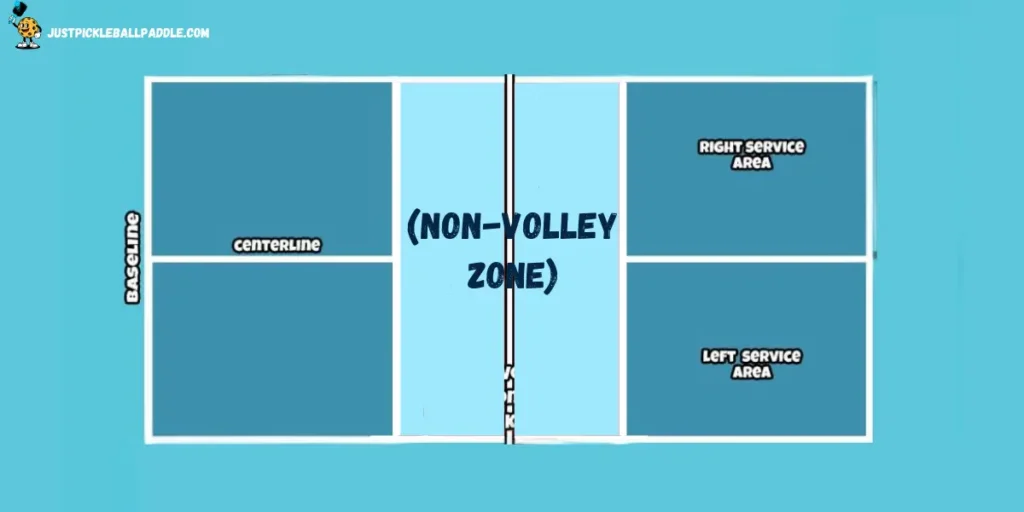
By enforcing a 7-foot buffer on both sides of the net, the kitchen forces players to rely on strategic dinks, controlled shots, and quick reflexes instead of simply overpowering their opponents. This results in longer rallies, more competitive exchanges, and a game that rewards smart positioning over brute force.
Another reason for the non-volley zone is fairness. Without it, taller or more athletic players would have an overwhelming advantage, as they could simply hover near the net and put every shot away. The kitchen ensures that all players, regardless of physical ability, have an equal opportunity to succeed by focusing on strategy and finesse rather than just power.
Pickleball Kitchen Rules and the Erne
While most players respect the non-volley zone rules, advanced players have found a way to legally bypass kitchen restrictions using a move called the Erne. The Erne is a special technique that allows a player to volley the ball close to the net without stepping into the kitchen, making it a game-changing shot when executed correctly.
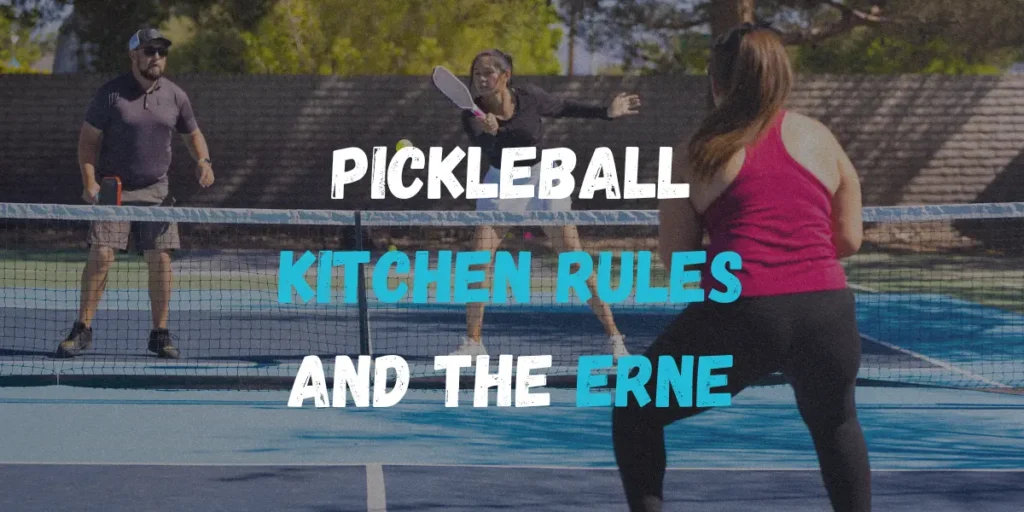
An Erne is typically set up by positioning yourself just outside the kitchen and then quickly moving to the very edge of the court near the sideline. Instead of volleying from behind the kitchen line, the player steps outside the court entirely and hits the ball while positioned beyond the kitchen boundary.
Since they are no longer in the non-volley zone, they can legally volley without breaking any kitchen rules.
This move is highly effective because it cuts off angles, surprises opponents, and allows aggressive net play without violating the kitchen restrictions. However, it requires precise timing, quick footwork, and the ability to read an opponent’s shot in advance.
How Is an Erne Legal?
The Erne is legal because it follows all the rules of the non-volley zone while allowing a player to take an aggressive position at the net. There are two ways a player can execute an Erne while staying within the rules:
- Jumping Over the Kitchen: A player can jump over the non-volley zone and land outside the court near the sideline before making contact with the ball. As long as they don’t touch the kitchen or its lines while volleying, the shot is legal.
- Running Outside the Court: Instead of stepping into the kitchen, a player can run outside the court and position themselves right next to the sideline. This allows them to volley the ball legally from a forward position, avoiding the kitchen entirely.
The Erne is a favorite move of mine and advanced pickleball players because it lets them attack at the net without breaking kitchen rules. However, it’s a risky shot—if mistimed, it leaves the player out of position and vulnerable to counterattacks.
FAQs
No, stepping on the kitchen line while volleying is a fault because the line is considered part of the non-volley zone. Even if just a toe or heel touches the line while making a volley, it results in a fault. This is why players stay just behind the line to ensure they don’t commit an accidental violation.
No, if your momentum carries you into the kitchen after hitting a volley, it is still a fault, even if you made contact with the ball legally. This rule exists to prevent players from gaining an unfair advantage by rushing the net.
Yes, your paddle can cross into the kitchen as long as no part of your body touches the non-volley zone or its lines. The rule only applies to physical contact with the kitchen, not the position of your paddle.
The best strategy is to stay just behind the kitchen line, allowing quick volleys without risking faults. Skilled players use dinking, which involves soft, controlled shots to force opponents into a patient, strategic exchange.
The term “kitchen” is believed to come from shuffleboard, where it refers to a penalty zone. In pickleball, stepping into the kitchen at the wrong time leads to a fault, similar to shuffleboard’s penalty system. Others believe the name was simply created for fun and stuck over time.
Conclusion
The kitchen rules in pickleball ensure fair play by preventing players from dominating the net with volleys. Understanding these rules helps you avoid unnecessary faults and develop a smarter playing style.
Volleys are not allowed inside the kitchen or on its lines, but you can step in freely after the ball bounces. Be cautious of your momentum, as stepping into the non-volley zone after a volley still results in a fault.
Advanced techniques like the Erne offer a way to attack at the net without violating kitchen rules, making them valuable for skilled players. However, for most, the best strategy is to stay just behind the kitchen line, allowing volleys while maintaining legal positioning.
By mastering footwork, dinking, and positioning, you can play a more strategic and effective game. Whether you’re a beginner or a competitive player, respecting the kitchen rules will help you improve and win more points.

